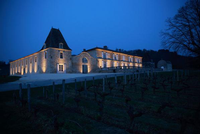Château Lassègue, Saint Émilion Grand Cru Classé, 2016 (Acadia Imports, $60): To a geeky wine lover, comparing the same wines from two different vintages is some of the most fun that can be had during a coronavirus lockdown. Ideally, the wines will reveal differences that go beyond their difference in age and development. Ideally, you will be able to taste the mark of the specific vintage in each wine.
Perhaps with the precise intention of intriguing bored, shut-in Americans, Château Lassègue has released its current 2016 grand vin alongside a library selection, the 2012. Father and son vignerons, Pierre and Nicholas Seillan,

intend the dual release to enable wine lovers “to discover the character of a newer release…while at the same time enjoying a library release in its prime drinking window.”
I tasted the two wines side by side and did in fact find the 2012 in its prime drinking window — a window that for me extends a few years into the future although the wine is perfectly ready now. The 2016 likewise is very drinkable now — the wine’s rich style makes it delicious upon release — but it has a long and promising future appropriate for a young Bordeaux from a fine vintage.
Both wines are predominantly Merlot with Cabernet Franc and a small amount of Cabernet Sauvignon. (In 2012, the ratio is 70 percent Merlot to 25 percent Cab Franc and 5 percent Cab Sauv; in 2016 it is 60 to 33 to 7.)
The 2012 vintage in Bordeaux was not an acclaimed vintage, although Merlot on the Right Bank (such as in Saint Émilion) fared better than Cabernet Sauvignon on the Left Bank. Typical of the vintage, the 2012 Lassegue is surprisingly perfumed for a Bordeaux, especially when the wine has had some aeration in the glass. I found aromas of blackberry fruit topped by lovely floral notes (violets, rose petals and lilac, suggest the Seillans) and classic Bordeaux scents of polished leather, lead pencil and cigar box. In the mouth, the wine is medium-bodied and supple in texture, with a strong tannin frame. Within that tannin frame, the fruit is fairly light and pretty, showing notes of mushroom, red cherry and black currants, along with fresh herbs. A key to getting the most enjoyment from this wine is to give it enough air, and a wide enough glass, for its aromatics to emerge.
In Bordeaux, 2016 is considered a great vintage, ranked 94 to 98 points by some critics. In tasting the 2016 Château Lassègue you understand immediately that the vintage produced wines of rich, ripe fruit. The aromatics pale in comparison to the 2012’s, but the wine’s fullness, richness of texture, apparent roundness in your mouth, and seamless balance are impressive. Before you label the wine as California-style in your mind, let me add that fine notes of minerality permeate the wine’s taste, a signature of Bordeaux. And as ripe as the fruit is, that fruit is still fresh, not overripe, not baked, not jammy. Counter-intuitively, while the older vintage benefits from aeration, the 2016 is beautiful in the glass from the get-go.
Tasting the 2012 and 2016 Château Lassègue side by side reveals many fascinating contrasts, not only in the development of the 2012 wine (mushroom, earthiness) versus the youthfulness of the 2016 but also in the character of the vintages. While the 2012 is particularly perfumed, its tannin speaks to classic Bordeaux structure; the 2016 instead expresses the ripeness potential of today’s Bordeaux, yet it manages to retain the freshness and the mineral edge of the region.
2016 Château Lassègue, 93 Points
2012 Château Lassègue, 90 Points